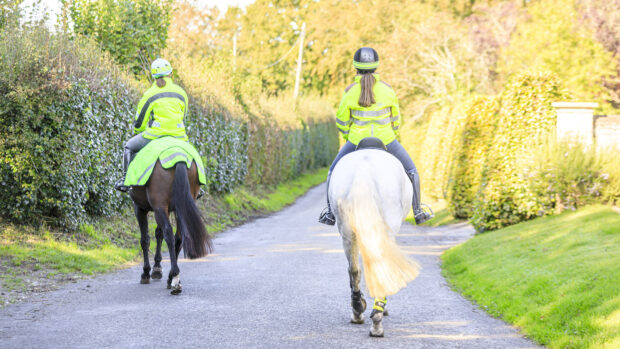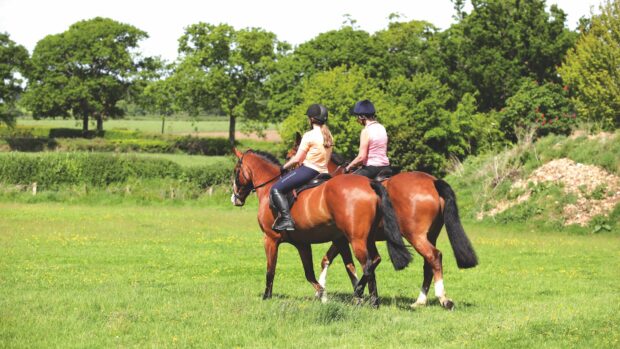Collaboration and building relationships with horse owners are high on the agenda as police forces come together to tackle equine and rural crime.
In June, the National Police Chiefs Council’s “equine priority delivery group” (EPDG) met to consider what can be done to support the equine community under its new three-year strategy. The group comprises forces across the UK, with input from organisations including the British Horse Society (BHS), World Horse Welfare, and the RSPCA.
Objectives include reducing theft, tackling fly-grazing and neglect, and improving collaboration between regions to reduce cross-border equine crime.
The group’s national lead, inspector Korine Bishop of Hampshire Constabulary, told H&H the aim is to get forces working towards the same objectives.
“We’re considering what best practice looks like and how we can collectively support the equine community,” she said.
“We have prevention, intelligence and enforcement leads and we’ve also set up a sub-group around green-yarding, because we know there are issues with loose horses in certain areas of the country.”
Inspector Bishop hopes the group will bring a national approach to equine crime recording.
“Different forces use different recording systems so it can be difficult to get figures on, for example, tack theft, but as part of this group we’re working more collaboratively,” she said.
“It’s trying to share information and discuss what’s going on in different areas. Sometimes when you look at forces, there’s sort of this straight line when it gets to the border, but criminals don’t work within borders so it’s looking at how we can support across forces.
“Over the next 12 months, I want to create some national recommendations and a national equine operation that everyone knows as a brand,” she added.
A number of forces have also relaunched horsewatch schemes this year including West Yorkshire Police, as they look to build on relationships with horse owners.
“Not only will we be concentrating on crime prevention advice, we want to focus on incident reporting, how to gather best evidence and what we can do with it. We will look at local neighbourhood policing teams and make sure we have a contact in each team that can link in with the equestrian community,” said West Yorkshire Police sergeant Terri Green.
“We want to highlight things like the Pass Wide and Slow initiative and the importance of wearing high-vis. We want to make sure people log incidents with the BHS – while we’re the ones that can take action, the BHS needs these statistics to support the work we do.”
Sergeant Green plans to engage with owners via the West Yorkshire Police horsewatch Facebook page.
“I want to ask owners for their crime prevention advice – police have all the standard stuff, but I want to hear from owners what works and what doesn’t and share this information and learn from each other,” she said.
The new Scottish Partnership Against Rural Crime (SPARC) strategy launched for 2022–2025 with road safety, theft, horse interference and access on the equine agenda. Led by Police Scotland, SPARC’s 22 member organisations include local partnerships and the BHS – which played a leading role in the strategy.
Police Scotland national rural crime coordinator inspector Alan Dron told H&H the strategy will build on previous work, including the force’s road safety campaign Lose the Blinkers. Work will also be done around countryside access to build on relationships between riders and other users and tackle issues such as dog attacks on horses.
“The police, along with SPARC partners, will work on the priority issues and over the three years we’ll come up with different innovations and tactics that will constantly work towards achieving what the BHS has put in as indicators of success – such as more educated drivers, fewer accidents, uptake in protective marking schemes,” said Inspector Dron.
“We want owners and livery yards to get involved; if there is a bad bit of road and you want a Lose the Blinkers operation set up or for our teams to do theft marking, then speak to your local representative. That’s what we’re here for.”
BHS director of safety Alan Hiscox told H&H the society was “delighted” to play a leading role in the SPARC strategy.
“Building strategies like this and the EDPG will provide riders and owners with greater guidance on how to confidently implement prevention steps and reduce rural crime,” he said.
You might also be interested in:

New stickers aim to prevent trailer theft following police crackdown

Money seized from criminals to help Horsewatch group
‘It feels good that the funds have come from proceeds of crime and are now being used for crime prevention

Subscribe to Horse & Hound magazine today – and enjoy unlimited website access all year round
Horse & Hound magazine, out every Thursday, is packed with all the latest news and reports, as well as interviews, specials, nostalgia, vet and training advice. Find how you can enjoy the magazine delivered to your door every week, plus options to upgrade your subscription to access our online service that brings you breaking news and reports as well as other benefits.




